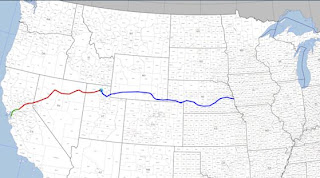Although
in 1865 the United States had about 35000 miles of railroad track, almost all
of it located at the east of Mississippi River. After the Civil War, railroad
construction expanded dramatically, linking the distant region of the nation in
a transportation network. The railroad track construction is known as the
Transcontinental Railroad now.
The
railroad boom began in 1862, when President Lincoln signed the Pacific Railway
Act. This act provided for the construction of a transcontinental railroad by two
corporations, the Union Pacific and the Central Pacific. At that time, they didn't have enough labor and sources to build the railroad. They had to be
transported from the Missouri River. And in order to get labors, they employed
people from other countries, like China. The Central Pacific starting from the
west, laid a total of 688 miles of track; while, the Union Pacific starting
from the east, laid 1086 miles. On May 10, 1869, hundreds of spectators
gathered at Promontory, Utah, to watch dignitaries hammer five gold and silver
spikes into the final rails that would join the Union Pacific and Central
Pacific.


No comments:
Post a Comment